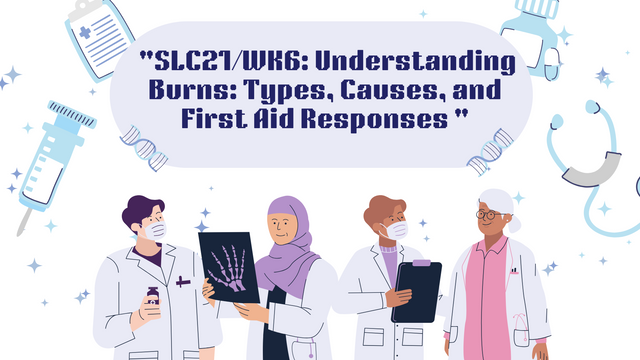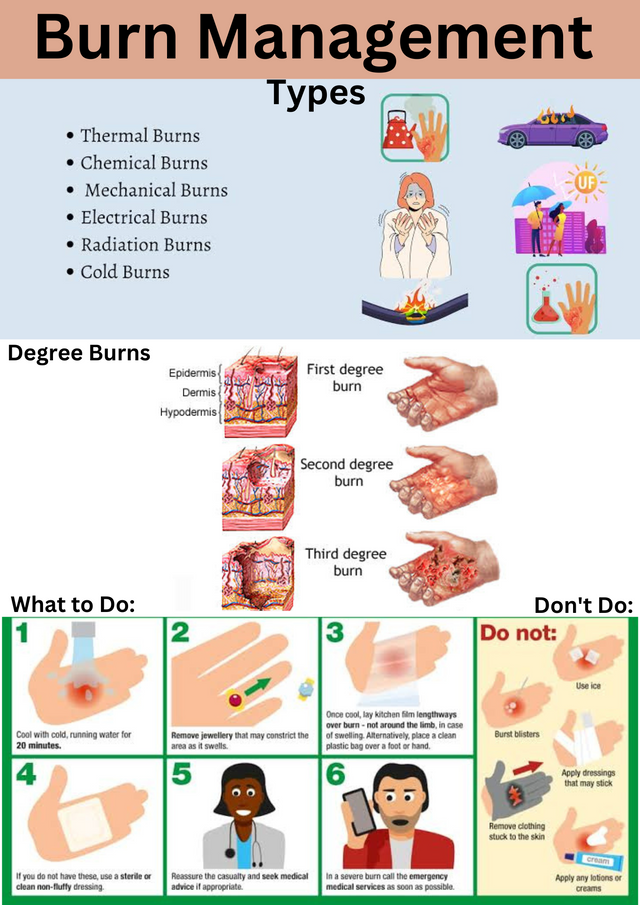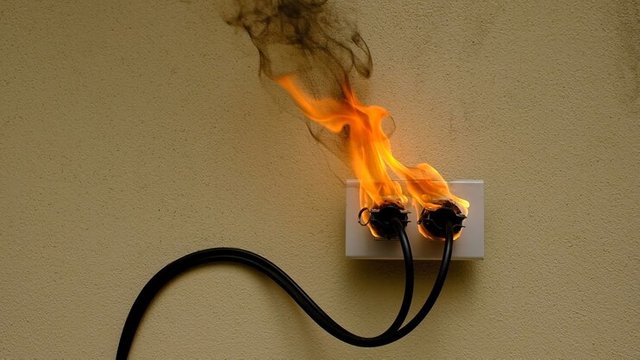 |
|---|
Write a detailed first aid response for the following scenario: " You witness a child accidentally spilling hot tea on their arm. What immediate steps will you take? What actions will you avoid? Include considerations for burn severity and explain your reasoning. "
The immediate action that I will first take if I should have a child accidentally spilling hot tea on their arm is safety. I will quickly assess the surroundings in which the spill occurs to ensure there is no ongoing danger to the child in particular and myself who want to rescue the child. By doing so, I will calmly reassure the child to reduce panic. After ensuring the safety of the child, the next thing that I would do is removing of the cloth or another object that is close to the affected area if they are not stuck to the skin to prevent further skin damage and allow the burn to cool off.
Also, I will immediately place the burned area under cool or running water for at least 20 minutes. In a situation where there is no running water available, I will use a clean damp cloth to help stop the burning process, reduce pain, and reduce tissue damage. Once I notice that the burn is cooled I will then loosely cover it with a sterile or clean cloth to protect the burn from infection as said earlier.
In a situation where I notice that the child is in serious pain, I will give the child an age-appropriate dose of "over-the-counter" pain relief and ensure that the child remains calm and hydrated at the same time. However, if I notice severe pain in the child I will seek the attention of a medical doctor or call emergency services.
Actions to Avoid:
I will avoid applying butter, creams, or ointments so the heat won't trap the child's skin which can make the burn worsen. Also, the use of cold water or ice isn't allowed, and I would avoid extremely cold water to avoid tissue damage. I will also, avoid rapping the burn tightly because if I should do so, it will strictly circulate swelling. To this, I will avoid using adhesive dressings or fluffy because they can worsen the injury by the time it is removed,
By following these approaches and precautions which I have shared I can help to provide safety for the child and promote the best possible outcome to keep the child in good condition.
"A worker in a warehouse suffers an electrical burn after touching exposed live wires. The burn site shows entrance and exit points, with damage to the skin and underlying tissues. What are the first aid actions you should take, and what critical steps should you avoid? How does this differ from treating thermal burns?"
In a situation where there is an electrical burn the immediate first aid actions will be;
I will ensure that I present a sense of snotty by not touching the worker until I am certain that the power source has been turned off. By doing so I will locate the circuit breaker, or switch and disconnect the power supply before touching the worker. In a situation that's not safe for me, I will immediately call emergency services. Also, I will check for Responsiveness such as pulse, and bring which if the worker is not breathing I will immediately begin CPR.
To treat the burn, I will look for the exit and entrance wounds, which is another part of the treatment if found, I would avoid cooling the burns with water. What I would do is cover the burn sites with non-stick drawings or with ones sterile. I will ensure that I keep the worker and monitors sign and monitor for other injuries.
Critical Steps to About
I will avoid touching the worker until the power is turned off. By so doing it will prevent me from being electrocuted.
I will avoid applying water or ice to the burns because electrical burns can affect tissuesander which water can also worsen the tissue damage.
I will avoid unnecessary memory to avoid any internal injuries that could aggravate the worker from having more injuries.
Removing clothing can worsen the tissue damage which I will avoid.
Differences From Treating Thermal Burns
Electrical Burns
It causes internal damage if there is contact with live electricity.
Deep tissues organs and muscles are often affected.
Cooling is not recommended
It can cause nerve, and organ damage or cardiac arrest.
The risk is higher due to electrical disruption of extensive or heart rhythm tissue damage.
Thermal Burns
There is direct heat exposure; scalds, flames and others.
It affects surface skin layers, which get deeper if the situation is severe.
20 minutes is needed to cool the burn with water.
There are no distinct exit or entry points.
Anything about internal damage is rare unless inhalation burns happen.
"A worker in a factory accidentally spills a strong acid on their arm, causing immediate pain, redness, and blistering. A colleague tries to wash it off with water but notices the burn spreading."
a. Identify the type of burn.
Chemical burns is the type of burn since the worker in the factory accidentally spills a strong acid. Chemical burn is a type of burn that can damage tissues and skin deeply.
b. What went wrong during the initial first aid?
Well the things that went wrong during the initial first aid are;
Improper rinsing due to limited water. The water was not sufficient enough.
The burn could have spread if the acid ran to unaffected areas.
c. Propose the correct first aid steps and explain why each step is important.
Ensuring safety by using a barrier or protective gloves to avoid direct contact with the acid. To prevent further exposure the worker needs to be moved away from the spill area ASAP.
Contaminated clothing, accessories, or jewelry needs to be removed from the affected place.
The area needs to be flush with water. When flushing one needs to ensure that water flows away from the burn site to prevent the acid from spreading.
You are a first responder in a rural area. Two people are injured in a house fire: Person A has a large area of third-degree burns but is conscious and calm. Person B has second-degree burns on both legs and is in severe pain. You can only help one person immediately due to resource constraints. Whom do you prioritize, and why? Support your decision with medical and ethical reasoning. No
If I am to give priority it will be to the person who has third-degree burns but is not in pain, since it destroys nerves, leading to an absence of having no pain which despite having no pain can result in serious damage if advanced medical intervention is not provided. The other person, who has intense pain both in legs which is the second degree burns that is not in deep pain has a higher chance of surviving if immediate treatment is provided making person B benefit from first aid. The truth is treating person B, offers a higher chance of stabilizing, i.e healing
Based on survivability, person B's burns are survivable with timely intervention which is the second degree that is painful and less severe and needs immediate care. As for person A it is life-threatening because the burns can destroy all skin layers if care is not taken which without advanced medical care person A may not get to survive. In all and all quick medical intervention should be provided for both.
Create an infographic on burn management. Include the following: a. Types of Burns and Their Causes (Electrical, Thermal, etc) b. Different types of burns (1st, 2nd, and 3rd degree) c. First aid steps for minor and major burns d. What NOT to Do During Burn First Aid." Use visuals and short explanations for each point.

Canvas
Above is an Infographic on burn management, which covers types and causes of burns, degrees, first aid steps, and what not to do during first aid as seen in the Infographic image.
I am inviting; @dove11, @simonmwigwe, and @ruthjoe
Cc:-
@abdu.navi03

Interesting, I really love how you take time to explain your point especially when it comes to those things we should avoid. I remember a story of 7 family members who died by being electrocuted. How did it happen, it was out of ignorance, they were not aware thst they supposed to turn off the ight before touching the victim. It's was sad losing a whole family, apart from turning off the electricity, another safety precaution is using dry plank or bathroom slippers to avoid being electrocuted while trying to save someone. Thank you for this wonderful post.
Downvoting a post can decrease pending rewards and make it less visible. Common reasons:
Submit
May souls of the family who lost their life from an electrical burn Rest in peace. Electric is one of the things I am afraid of getting close to. Thanks for your support.
Downvoting a post can decrease pending rewards and make it less visible. Common reasons:
Submit
Another new day another new post Congratulations Long life Amen.👍🥰
Downvoting a post can decrease pending rewards and make it less visible. Common reasons:
Submit
Thanks
Downvoting a post can decrease pending rewards and make it less visible. Common reasons:
Submit
Well come dear.
Downvoting a post can decrease pending rewards and make it less visible. Common reasons:
Submit
Student Name: @josepha
Overall grade: 8.6
Plagiarism Check: Pass
AI Use: no
General Feedback: The student has shown a good understanding of this week's course. I definitely enjoyed reading your article. There were a few shortcomings which I'm sure will be avoided in the upcoming posts.
Thank you.
Regards,
@huzaifanaveed1
Downvoting a post can decrease pending rewards and make it less visible. Common reasons:
Submit